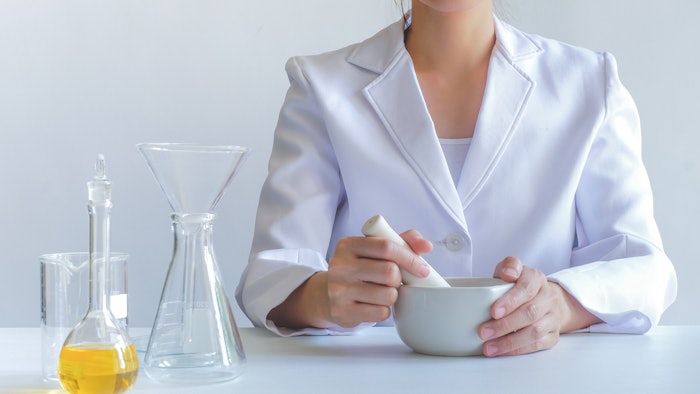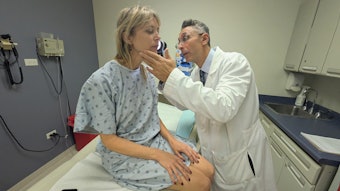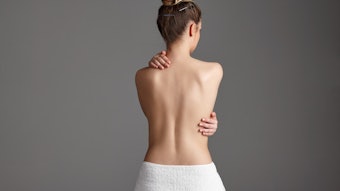
Something that can be described as “precious” has a built-in allure. Metals such as gold, silver and platinum instantly signal opulence, while workhorse minerals such as copper and zinc suggest a familiar strength and dependability. When used in skin care products, these elements not only have name recognition for the average consumer, but they effortlessly deliver the “everyday luxury” patients and consumers have come to expect, yet with a natural, of-the-earth quality that appeals to patients seeking “clean” products for their wellness routines.
“Everyone likes something that sparkles, and gold, in particular, has such a luxurious connotation to it,” says Angelia Inscoe, founder and CEO of Induction Therapies. “I tell doctors all the time: This is a way to bring a bit of glamour to the medical aspect of skin care. Everything now is about the experience, so you want to make skin care as quality an experience as you can.”
Metal- and mineral-based skin care isn’t new. Cleopatra is said to have applied gold to her skin, and gold, silver, zinc and copper have been used in Ayurvedic medicine to treat various diseases for millenia. Gold’s therapeutic uses have included treatments for ulcers, lupus and rheumatoid arthritis.1. 2.
What is new about the use of precious metals in today’s skin care lines is nanotechnology, also referred to as micronized ingredients. A growing body of research suggests that nanoparticles of metals and minerals in topical skin care not only improves the elegance of the formulation but also increases the ability of these actives to penetrate skin.
Following are some of most promising uses of metals and minerals in skin care topicals.
Gold
Research of gold’s use in cancer therapy, where it is used to absorb light, convert it to heat and selectively destroy tumor cells, has shown that the precious metal also offers anti-inflammatory and antioxidant properties, making it a promising addition to anti-aging topicals.3
“Twenty-four karat gold in skin care is super-trendy now for many reasons,” says Inscoe. “It has anti-inflammatory properties that calm the skin. It has antioxidant benefits to prevent free radicals from targeting and breaking up cells and it also helps with pigmentation.”
Products patients leave on, such as serums and eye masks, “provide the glow and dewy skin complexion that is so popular nowadays,” says Inscoe. “All Fitzpatrick skin types can benefit from gold.”
Micronized gold is also used to help deliver peptides, which have poor penetration but powerful mechanisms of action in aging and damaged skin. “The efficacy of colloidal gold [has to do with] the fact that it is chemically modified and combined with peptides, which upregulate collagen and elastin production,” says Luiz Felipe Stehling, head of innovation and international marketing at U.SK Under Skin in Brazil.
He notes that gold does not stimulate collagen and elastin production on its own, but it can protect against free radicals and deliver actives, such as peptides, to the fibroblasts. “The main character at play is the peptide. However, without the colloidal gold, the peptide will never reach the cell target,” he says. “It would either not penetrate through the skin or would be destroyed by [the skin’s] protection ‘surveillance’ system.”
Silver
Studies support silver’s use as an antimicrobial, antifungal and antibacterial agent.4 The National Institutes of Health notes that topical silver can be effective in treating burns, wounds and skin infections, which is why it’s used in bandages, deodorants and even exercise gear to combat bacterial growth..
Silver “eats” bad bacteria, leaving the good bacteria behind, and is excellent for calming inflammation, says Ailynne Marie Vergara-Wijangco, MD, a board-certified dermatologist and researcher with ThankYourskin.com.
Unsurprisingly, product formulators are exploring colloidal silver’s use as an effective treatment for acne— as a spot treatment and in washes for acne-prone skin as it is gentler than benzoyl peroxide and retinoids. Silver is popping up in non-acne related products as well, including anti-aging masks, serums and mists thanks to its skin-calming qualities.
Virginia Pelley is a freelance writer based in Tampa FL.
References:
- Galib, “Therapeutic potentials of metals in ancient India: A review through Charaka Samhita” J Ayurveda Integr Med (Apr-June 2011)
- Papp KA, “Systemic Gold Therapy,” Clinics in Dermatology; 9;4:535-551
- Goldstein A, “The Bright Side of plasmonic gold nanoparticles; activation of Nrf2, the cellular protective pathway,” Nanoscale; June 2016; 8(22):11748-59
- Zhang X, “Silver Nanoparticles: Synthesis, Characterization, Properties, Applications, and Therapeutic Approaches,” Int J Mol Sci. 2016 Sep 13;17(9):1534











